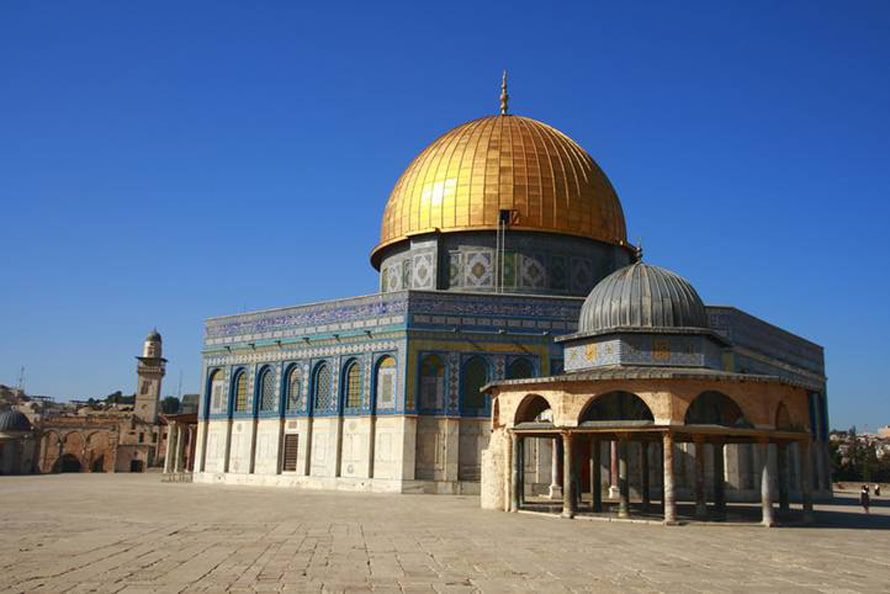
The archaeological history of Palestine is very rich, with approximately 12,000 sites in the West Bank, including East Jerusalem, and the Gaza Strip. As home to three monotheistic faiths that consider the city of Jerusalem a holy city, Palestine is the site of many holy shrines and an unique architecture.
Palestine has been influenced by various cultures which left their mark on the region since prehistoric times. Its cultural heritage goes back to the 4th century CE, when in the Eastern Roman Empire ancient churches such as Burqin and Abud arose in the West Bank. The Umayyad period (661-750) brought early examples of Islamic architecture. This period heavily influenced the entire Levant region in terms of its political and tribal powers’ luxurious standard of living. This standard is to be found in the designs of complex palaces containing auditories, baths, mosques, courtyards, and gardens.
During the Mamluk period (1250-1517) various types of buildings, especially religious institutions, left their mark on the Palestinian architectural landscape. The holy city of Jerusalem flourished, with madrassas (Islamic schools) and zawiyas (buildings especially for Sufis, the mystic school of Islam) being promoted. Public facilities, such as khans (roadside inns where travellers could eat and rest), souks (markets), and hammams (baths), were also part of the urban planning of the city.
Under Ottoman rule (1517-1917) a significant human settlement took place in the region, as more villages emerged influenced by Ottoman culture. After the fall of the Ottoman empire and the establishment of the British Mandate to Palestine, a department of antiquities was established in the 1920s to implement excavations and archaeological surveys. In 1929, the British government enforced the Antiquities Law; most of the work was done by British specialists as Palestinians did not possess the required skills for research.
After the collapse of Palestinian society in 1948 and the establishment of the State of Israel, Palestinians saw a full-scale destruction of their cultural heritage in the aftermath of the Arab-Israeli wars. Israel’s attempts to acquire a political, historical and cultural legitimacy in Palestine resulted in the exploitation, destruction and manipulation of the Palestinian cultural heritage. Under Israeli occupation, Palestinians were prevented from carrying out local excavations, and archaeological evidence from periods succeeding those of interest to the Israelis – classical, Byzantine, Islamic – was often neglected. Hundreds of archaeological sites have been looted and plundered during the years of occupation, and there has been an active illegal trade in cultural property.
In the 1970s, a national interest in re-affirming ‘Palestinian national identity’ was rekindled and Palestinians began to safeguard what remained of the local heritage: i.e. historical buildings, monuments, archaeological sites, artefacts and art objects. Following the Palestinian-Israeli agreement in 1993, the Ministry of Tourism and Antiquities was created, which sought to invigorate research. The Department of Antiquities and Cultural Heritage (DACH) was established under complex circumstances. Despite its lack of archaeological records and inadequate logistical support and equipment, the department sought to preserve some of the most endangered archaeological sites and historic buildings.

Preservation and conservation of Palestinian cultural heritage
The Palestinian Department of Archaeology, with international collaboration and funding, was able to carry out a number of major projects. The Emergency Clearance Campaign of one Hundred Sites, in 1996-1998, and a project for the protection of the cultural and historical landscape between 1998 and 2001 included major archaeological sites and historical buildings, as well as mosques, churches, monasteries and sanctuaries, such as the ancient churches of Burqin and Abud, as mentioned both dating to the Byzantine period, and the crusader churches of Sebastya and al-Birah. Historic mosques likewise preserved include al-Sabeen and Burham from the Mamluk period, the Omari mosques at Dura and Birzeit, as well as the sanctuaries of al-Qatrawani and Maqam al-Nuban.
Illustrative of the diversity of structures and sites that have been preserved are an 18th century castle in Ras-Karkar, the crusader Kahn in al-Birah, the Mamluk bath in the old town of al-Khalil (Hebron), the Ottoman Qaem-Maqam house in Tulkarem and the Beit al-Zarru villa in Ramallah. Maqam al-Qatrawani near Attara has also been conserved, together with the small natural forest and terraced landscape surrounding it. Similarly, the site of Dura al-Qarei provides a combination of historical ecology and technology, displaying traditional hydrological features in its natural and cultural landscape. Some historical buildings have been restored as ethnographic and archaeological museums or other types of cultural centres. The villages of Deir Istyia and Artas are being incorporated into larger complexes with multiple functions.
Among well-known sites excavated in the 20th century in the West Bank and Gaza are Tell Taannek (tell means ‘hill’ in Arabic), Tell al-Fara, Tell Dothan, Tell Balata, Tell al-Nasbeh, Tell al-Tell, Khan Radana, and Tell al-Ajjul (a Palestinian-Swedish excavation), which arose just before the foundation of Gaza City. Excellent examples of the efficiency of international collaboration with the department are the joint Palestinian-Dutch excavations at Khan Balama, the joint Palestinian-Italian excavations at Tell al-Sultan in Jericho, the Palestinian-Swedish excavation at Tell al-Ajjul, the Palestinian-French excavation at Anthedon, Tell al-Sakan and the Palestinian-Norwegian excavation at Tell al-Mafjer in Jericho. These joint projects have contributed to building a new postcolonial model of cooperation in archaeology based on mutual respect and interest, although some of the sites have been left unprotected during the thirty years of occupation.
In Gaza, Qaser al-Basha has undergone comprehensive restoration work. Major excavations also took place at Tell Umm Amer, Blakhyieh, Jabalia, and Tell al-Sakan between 1995-2006. The excavations at Tell al-Sakan are on-going despite the present difficulties. It is a major Palestinian site for the third millennium BCE, whose exploration will reveal the ancient history of the Gaza Strip. As the UNDP states, ‘Discovered by chance in 1998 during the construction of a housing complex, it is the only Early Bronze Age site presently known in the Gaza Strip. Inhabited between ca. 3300 and 2200 BCE, this settlement of more than 5 hectares was possibly the capital of the area at the time.’
The Mamluk castle of Khan Yunis underwent a series of restorations and consolidation work in 2005. In the northern districts in Palestine, the sites of Khan Balama, Burqin, Arraba, Deir Istyia, Barqawi Castle are also being restored. For the People of Shofeh, the Barqawi castle is more than just an impressive piece of architecture, it is a central element in their town’s identity and local mythology.
UNESCO and Palestine
Since October 2000, cultural sites in the Palestinian areas have suffered extensive damage. These sites have been subject to military bombings and shelling leading to partial or even total destruction. Attacks on cultural heritage sites have intensified since the last major incursions in April 2002 and January 2004, causing irreparable damage, especially in the historic towns and cities, including Bethlehem, al-Khalil (Hebron), Gaza, Beit Jala, Tulkarem, Salfit, Jenin, Gaza, Rafah, Abud, and Nablus. Many archaeological sites and historical buildings have been the target of Israeli military attacks, including during the last war on Gaza, when the ancient Gaza port of Anthedon, the Ottoman building of Dar al-Sariai and the governor’s house were damaged. Sieges, curfews, roadblocks and military closures imposed on the Palestinian cities and villages have prevented the DACH from attending to its tasks in the protection of the cultural heritage.
UNESCO weighed in when it affirmed that the ‘Palestinian sites are cultural treasures that the Palestinian people wish to protect and share with the world’. Condemning Israel’s annexation of Rachel’s and Joseph’s tombs, and affirming Palestinian sovereignty over them, UNESCO proclaimed, ‘the Israeli Government has attempted to highlight the Jewish character [of these sites], while erasing or neglecting the universal character of these heritage sites’. This cultural hegemony, according to UNESCO, has been used ‘as a political tool to maintain and entrench control over Palestinian lands and as a pretext for its continued settlement activity’. Again in this instance, UNESCO appealed to Israel to recognize its commitments as an occupying power and to recognize that ‘confiscation and developments of Palestinian heritage sites and cultural property by Israel is prohibited under customary international law’.
Palestinians are seeking protection for their endangered cultural heritage, along with their membership of UNESCO since 2011. In the framework of the UNESCO World Heritage Centre’s contribution to the protection of Palestinian heritage, an international workshop was held in Jericho in February 2005, aiming at discussing strategies to preserve the outstanding universal value of Tell al-Sultan (Ancient Jericho), the oldest known city in the World. Palestinians also seek World Heritage Status for up to twenty sites.








Palestine’s folk heritage

Palestine’s folk heritage, including craft-making, oral traditions, and music, is part of the national wealth. However, many factors threaten the survival and continuity of the cultural heritage in Palestine, such as Israeli military occupation and the lack of awareness of the importance of cultural heritage among the public.

